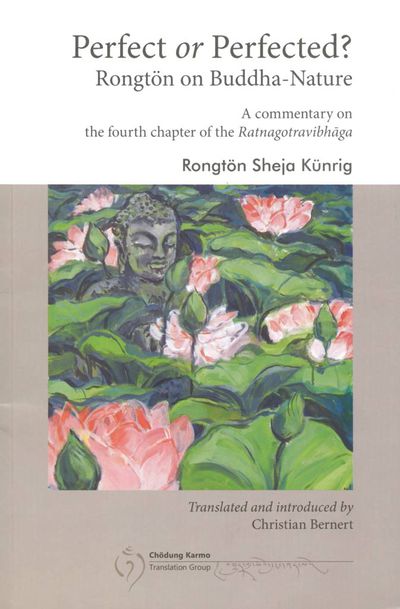Perfect or Perfected? Rongtön on Buddha-Nature
No edit summary |
No edit summary |
||
| (9 intermediate revisions by 5 users not shown) | |||
| Line 1: | Line 1: | ||
{{Book | {{Book | ||
|BookPerson={{Book-person | |BookPerson={{Book-person | ||
|PersonPage=Rong ston shes bya kun rig | |||
|PersonName=Rongtön Sheja Kunrik | |PersonName=Rongtön Sheja Kunrik | ||
}}{{Book-person | }}{{Book-person | ||
|PersonPage=Bernert, C. | |||
|PersonName=Christian Bernert | |PersonName=Christian Bernert | ||
}} | }} | ||
|FullTextRead=No | |FullTextRead=No | ||
|BookToc=*Foreword vii | |BookEssay=This commentary is a key source for teaching buddha-nature and the ''Gyü Lama'' in the Sakya tradition and was authored by the famous Sakya master [[Rongtön Sheja Kunrik]]. The book is an updated version of Bernert's dissertation, which includes an annotated translation of Rongtön's commentary on the fourth chapter of the ''Gyü Lama'' (''Ratnagotravibhāga'') and an analysis of Rongtön's position, which is a useful starting point for understanding the view of buddha-nature teachings from a Sakya perspective. Rongtön's view of buddha-nature follows the analytical tradition of [[Rngog blo ldan shes rab|Ngok Loden Sherab]], but is somewhat complex, and Bernert does a good job of presenting the complexities in his analysis. | ||
*Preface and Acknowledgments ix | |BookToc=* {{i|Foreword|vii}} | ||
*I - Translator's Introduction | * {{i|Preface and Acknowledgments|ix}} | ||
* {{i|I - Translator's Introduction: The Doctrine of Buddha-nature|1}} | |||
**Overview 1 | ** {{i|Overview|1}} | ||
**Sources 4 | ** {{i|Sources|4}} | ||
**The Sutras 4 | *** {{i|The Sutras|4}} | ||
**The Sastras 8 | *** {{i|The Sastras|8}} | ||
*The Ratnagotravibhaga 11 | * {{i|The Ratnagotravibhaga|11}} | ||
**The Text of the Ratnagotravibhaga 11 | ** {{i|The Text of the Ratnagotravibhaga|11}} | ||
**The Question of the Authorship of the Ratnagotravibhaga 12 | ** {{i|The Question of the Authorship of the Ratnagotravibhaga|12}} | ||
**The Ratnagotravibhaga in India 13 | ** {{i|The Ratnagotravibhaga in India|13}} | ||
**The Ratnagotravibhaga in Tibet 15 | ** {{i|The Ratnagotravibhaga in Tibet|15}} | ||
***The Analytical School of Loden Sherab 15 | *** {{i|The Analytical School of Loden Sherab|15}} | ||
***The Meditative School of Tsen Khaboche 19 | *** {{i|The Meditative School of Tsen Khaboche|19}} | ||
**Previous Studies and the Aim of the Present work 20 | ** {{i|Previous Studies and the Aim of the Present work|20}} | ||
*Rongton and His Presentation of Buddha-nature 22 | * {{i|Rongton and His Presentation of Buddha-nature|22}} | ||
**A Brief Biography of Rongton Sheja Kiinrig 22 | ** {{i|A Brief Biography of Rongton Sheja Kiinrig|22}} | ||
**Rongton's Presentation of Buddha-nature 23 | ** {{i|Rongton's Presentation of Buddha-nature|23}} | ||
***Introduction 23 | *** {{i|Introduction|23}} | ||
***The Buddha Qualities and the Dharmakaya 26 | *** {{i|The Buddha Qualities and the Dharmakaya|26}} | ||
***The Dhatu as a Cause 28 | *** {{i|The Dhatu as a Cause|28}} | ||
***The Gotra and the Luminous Nature of the Mind 29 | *** {{i|The Gotra and the Luminous Nature of the Mind|29}} | ||
***Rongton and the Ratnagotravibhagavyakhya 33 | *** {{i|Rongton and the Ratnagotravibhagavyakhya|33}} | ||
***Summary 34 | *** {{i|Summary|34}} | ||
**Notes on the Translation 35 | ** {{i|Notes on the Translation|35}} | ||
*II - Translation: An Extensive Exposition of the Dhatu | * {{i|II - Translation: An Extensive Exposition of the Dhatu: All Sentient Beings Have Buddha-Nature|37}} | ||
*Determining the Dhatu by Means of a Tenfold Presentation 44 | * {{i|Determining the Dhatu by Means of a Tenfold Presentation|44}} | ||
**Essential nature and cause 44 | ** {{i|Essential nature and cause|44}} | ||
**Result and function 50 | ** {{i|Result and function|50}} | ||
**Connection 62 | ** {{i|Connection|62}} | ||
**Manifestation 65 | ** {{i|Manifestation|65}} | ||
**States 67 | ** {{i|States|67}} | ||
**All-pervasiveness 69 | ** {{i|All-pervasiveness|69}} | ||
**Immutability 71 | ** {{i|Immutability|71}} | ||
**Inseparable qualities 97 | ** {{i|Inseparable qualities|97}} | ||
*Summary 106 | * {{i|Summary|106}} | ||
*Appendix: Detailed Outline of the Commentary 107 Glossary 113 Tibetan Names and Places 125 | * {{i|Appendix: Detailed Outline of the Commentary|107}} | ||
*Bibliography 129 | * {{i|Glossary|113}} | ||
*Index 137 | * {{i|Tibetan Names and Places|125}} | ||
* {{i|Bibliography|129}} | |||
* {{i|Index|137}} | |||
|AddRelatedTab=Yes | |AddRelatedTab=Yes | ||
|PostStatus= | |PublisherLogo=File:Vajra books logo.png | ||
|ExtraCategories=Sakya | |PostStatus=Approved | ||
|ExtraCategories=Sakya; Vajra Books | |||
|StopPersonRedirects=No | |||
|BookParentPage=Secondary Sources | |||
|AddQuotesTab=Yes | |AddQuotesTab=Yes | ||
}} | }} | ||
Latest revision as of 22:57, 11 August 2020
As the most important canonical treatise on Buddha-nature, the Ratnagotravibhaga (also known as Uttaratantrasastra, Tib. rgyud bla ma) established the doctrinal foundations for the Mahayana philosophy of tathāgatagarbha, the doctrine according to which all sentient beings are either inherently buddhas or endowed with the potential for awakening. Among the most prominent Tibetan commentaries on this text figures that of the Sakya master Rongtön Sheja Künrig, a prolific writer who was active during the golden age of Tibetan Buddhist philosophy. Refuting, on one hand, the notion that Buddha-nature is synonymous with mere emptiness, and on the other that the mind is inherently endowed with the Buddha qualities, Rongtön argues for an understanding of Buddha-nature that embraces both aspects of the nature of mind: cognizance and emptiness.
Rongtön Sheja Künrig (1376-1449) figures among the greatest teachers of the Sakya tradition. Particularly renowned for his commentaries on the Five Treatises of Maitreya, his vast erudition, and extensive teaching career made him one of the most influential masters for the scholastic lineages of all schools of Tibetan Buddhism. This volume contains an annotated translation of Rongtön Chenpo’s commentary on the central chapter of this treatise (including the relevant stanzas of the root text), along with an extensive introduction to the historical development of this doctrine and an analysis of Rongtön’s position. (Source: Vajra Publications)
| Citation | Bernert, Christian, trans. Perfect or Perfected? Rongtön on Buddha-Nature: A Commentary on the Fourth Chapter of the Ratnagotravibhāga (vv.1.27-95[a]). By Rongtön Sheja Künrig (rong ston shes bya kun rig). Kathmandu: Vajra Books, 2018. |
|---|---|



